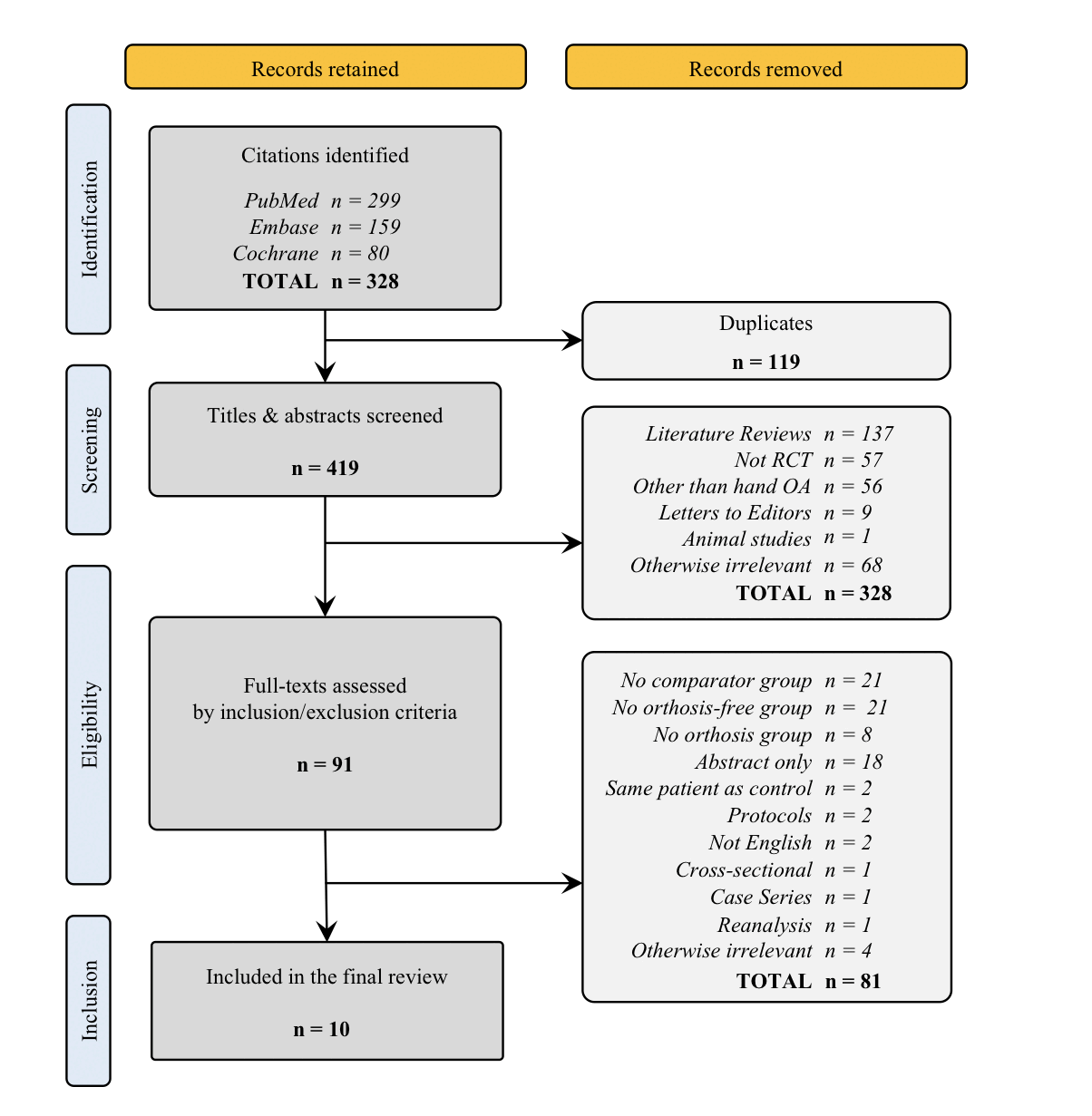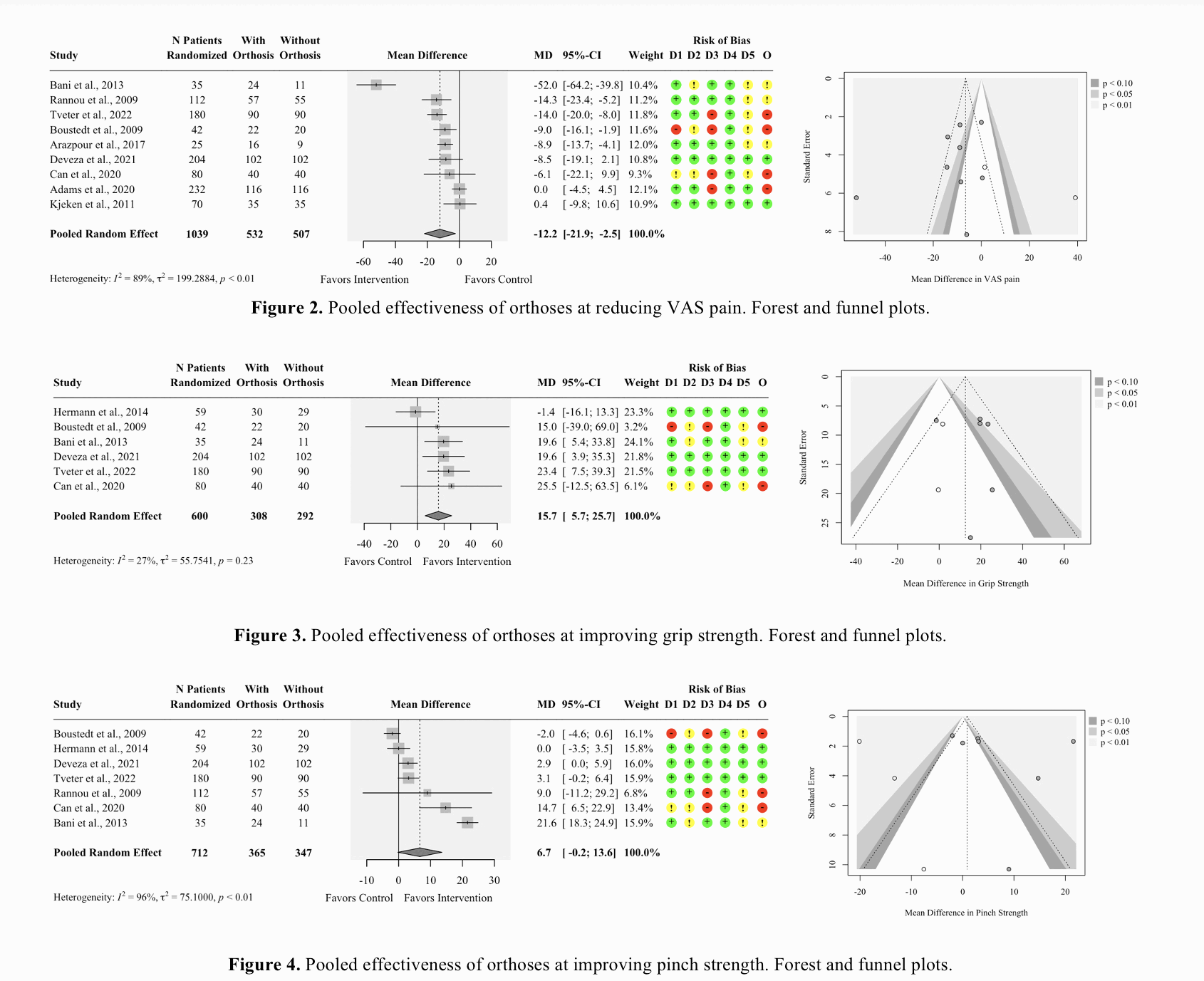Session Information
Session Type: Poster Session B
Session Time: 10:30AM-12:30PM
Background/Purpose: Hand osteoarthritis (OA) affects 11-33% of men and women in their 50s and 60s, significantly affecting the quality of life of those afflicted.Orthoses are used in the management of hand OA with no clear evidence to support it. In this systematic review and meta-analysis, we evaluate the effectiveness of using hand orthoses in the management of hand OA.
Methods: We searched PubMed/MEDLINE, Embase, and Cochrane CENTRAL for relevant citations using a combination of keywords, MeSH terms, and Emtree terms. We included all published controlled studies available in English and with no limits applied to the date of publication, evaluating the effectiveness of various hand orthoses (rigid and semirigid, custom and prefabricated) for patients with hand OA against no use of any orthosis. We excluded studies with no orthosis-free comparator. VAS pain, grip and pinch strength were the main outcomes, a random effects generic inverse variance meta-analysis was carried out to determine the overall effectiveness of using orthoses for hand OA based on these three outcomes. Publication bias was assessed using Egger’s test, trim and fill analysis, and visualized using funnel plots. Risk of bias was assessed using the RoB2 tool.
Results: A total of 538 relevant citations were identified in the databases. Following removal of 119 duplicates, exclusion of 328 citations in the initial screening, and 81 articles in full text review, a total of 10 studies published from 2009 to 2022 were included in our analysis (Figure 1), providing data on a total of 1142 patients with hand OA (78% women), randomized to receive treatments either with (532) or without (507) use of hand orthoses, and followed up for a duration of 4 to 48 weeks (mean = 16.1, SD = 12.8). VAS pain was reported in 8 studies, and pinch and grip strength were reported in 7 and 6 studies, respectively. The AUSCAN pain index data were used to substitute VAS pain in one study, thus yielding an analysis of subjectively reported pain data from 9 studies. We found a significant reduction in reported VAS pain when using orthoses (Mean Difference = -12.2, 95%CI [-21.9; -2.5]; Figure 2), and there was a considerable heterogeneity among studies (I2 = 89%, p < 0.01). Grip strength significantly increased by 15.7N (95% CI [5.7; 25.7], I2 = 27%, p = 0.23; Figure 3), whereas no significant difference was observed for the change of pinch strength between the two groups (Mean Difference = 6.7N, 95% CI [-0.2; 13.6], I2 = 96%, p < 0.01; Figure 4). Publication bias was non-significant (Egger’s p > 0.05) for all three outcomes, with trim and fill analysis suggesting the possibility of few unpublished studies with non-significant results. Four of the included studies had high overall risk of bias, 3 raised some concerns, and three were at low risk.
Conclusion: The published literature indicates that provision and use of hand orthoses for patients with hand OA may be an effective way to reduce pain and improve grip strength. Our meta-analysis supports the possibility of achieving clinically significant reduction in pain scores and increase in grip strength. However, given the limited number of identified high quality studies, further research is necessary to more accurately determine the effectiveness of hand orthoses.
To cite this abstract in AMA style:
Alhammadi N, Alqahtani H, Hakobyan B. The Effectiveness of Orthosis for the Management of Hand Osteoarthritis-a Systemic Review and Meta-analysis [abstract]. Arthritis Rheumatol. 2024; 76 (suppl 9). https://acrabstracts.org/abstract/the-effectiveness-of-orthosis-for-the-management-of-hand-osteoarthritis-a-systemic-review-and-meta-analysis/. Accessed .« Back to ACR Convergence 2024
ACR Meeting Abstracts - https://acrabstracts.org/abstract/the-effectiveness-of-orthosis-for-the-management-of-hand-osteoarthritis-a-systemic-review-and-meta-analysis/


